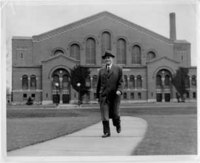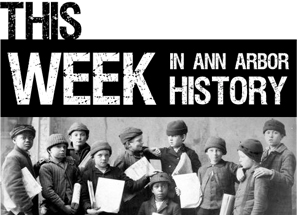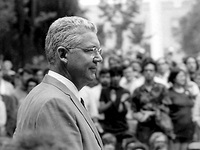University of Michigan expands with golf course, Mo-Jo Residence Hall
Welcome to This Week in Ann Arbor History, a look back at some notable moments from the city's past:
1930: The year of grand openings for U-M Golf Course, Mosher-Jordan hall
Fielding Yost's legacy is usually tied to his Point-a-Minute football teams that put the University of Michigan on the map, and for the stadium that would become college football's "Big House," but the University of Michigan Golf Course was his vision as well.

Fielding H. Yost, outside the fieldhouse bearing his name. Today it is the Yost Ice Arena.
The facility has come a long way in the 80 years since — it didn't even have a clubhouse when built, and golfers had to trek across Stadium to the sports building at Ferry Field to shower up. A clubhouse was built later and the course had a major, multi-million dollar renovation in 1994.
Mosher-Jordan Residence Hall opened on Monday, Sept. 22 as a residence hall for 450 female students at the University of Michigan. The residence hall was named in honor of Eliza M. Mosher and Myra B. Jordan, former deans of women at the university. A celebration later that fall celebrated its opening.
In 1968 Mo-Jo went co-ed and in 2008 it reopened after a major renovation, part of the University's overhaul of its "Hill neighborhood" residence halls, according to the university.

Auto ban remains strict
In 1927 the Board of Regents banned Michigan students from operating vehicles for personal and social use, aside from certain breaks in the year, as determined by the university.
"No student may operate a motor vehicle during the official school year with the exception of definitively stated times," explained the Daily. The university still granted between 250 and 500 permits, for business and family use.
Assistant Dean of Students Walter B. Rea made clear the penalty for violating the policy: Expulsion. "Cars stored in Ann Arbor ... must be registered with license number and location of garage in the office of the assistant to the dean," read the Daily.
Things changed over the next 40 years, as students became more distrustful of their leaders, both at the local and the national level.
1969: "We don't need no thought control"
U-M President Robben Fleming took office on Oct. 1, 1968, at a time when Vietnam-War frustration had reached the boiling point. In a sense, Fleming was a "wartime" university president, and he walked a difficult line between letting student protesters have their say and keeping order.
In March 1969, members of Students for a Democratic Society barred a Navy recruiter from a recruiting session. That June, the four-day-long Battle of Ann Arbor was waged between University of Michigan students and the Ann Arbor police force. (The U-M Department of Public Safety wouldn't come about until two decades later.)
Then on Friday, Sept. 26, 1969, more than 300 city and state police, as well as Washtenaw and Oakland County sheriff's officers, swarmed into the Literature, Science and the Arts Building at Fleming's behest to remove protesters staging a sit-in, The Ann Arbor News' reported.
"This may erode student confidence in me," Fleming admitted at the time, calling his decision to call 911 an "agonizing" one. "Maybe somebody else could do a better job. If it means I have to go, that's all right."
Students tried to stage a follow-up solidarity strike, but the effort fell flat, and Fleming stayed on as president into 1979. He also took a turn as interim president, steadying the ship between the tenures of Harold Shapiro and James Duderstadt.

Fleming at a 1969 student protest.
Fleming's run-ins with student protesters didn't end with a few arrests in the fall of 1969. The very next year the Black Action Movement stepped forward with demands for increased enrollment and financial support for black students. They staged a 12-day student strike and won significant concessions, including assurance the university would aspire to 10 percent black enrollment, up from 3 percent at the time.
Though Fleming's tenure extended far beyond the Vietnam era, he is best remembered for his cool, collaborative approach in addressing students' concerns and making the university more progressive and diverse. Fleming died in January at the age of 93.
James David Dickson can be reached at JamesDickson@AnnArbor.com.


Comments
Wystan Stevens
Wed, Sep 29, 2010 : 10:28 a.m.
@James, I am enjoying this series.
Wystan Stevens
Wed, Sep 29, 2010 : 10:26 a.m.
@Jeff: I too was working in the University Library in 1964, and met Virginia Tibbals. She was a sister of Truman Tibbals, the owner of Drake's candy shoppe and tea room. Clarence Little, who was not a bachelor, may have been a bit too dashing for Ann Arbor's tastes. Remember that he was still in his twenties when he was U-M president, and already headed toward a messy divorce while enjoying his escapade with the dean. Little and his wife, Katherine Andrews, formally separated in January, 1929, when he also (under pressure from the Board of Regents) announced his resignation from the presidency, to take effect at the end of the school year. The whole sordid business was alluded to by the Assistant Dean of Women, Jean Hamilton, in her novel, "Wings of Wax" (the title refers to the Icarus legend). Hamilton heaped her scorn while hiding behind a pseudonym, "Janet Hoyt." In the novel, Little is Victor Marston, the president of Woban College. She kills him off in a car crash, along with his paramour. In 1929, Ann Arbor was too small for a scandal of that kind. Probably still is.
W
Wed, Sep 29, 2010 : 3:57 a.m.
This is an excellent feature; keep it up.
thomas h blaske
Tue, Sep 28, 2010 : 1:38 p.m.
President Fleming's courage & good sense & taking responsibility for his decisions -- all these are a model of great leadership.
treetowncartel
Tue, Sep 28, 2010 : 11:28 a.m.
Didn't the renovation of the course reverse the nines? Making the 14th hole today's current 5th hole? 14 is the par 3 along Main street. The only hole that really isn't open to approach, if I have the right context of what yost Meant, is today's number 18.
Jeff Renner
Tue, Sep 28, 2010 : 9:52 a.m.
James - C.C. Little was president only from 1925 - 1929, so it would during the period.
Laurel Erickson
Tue, Sep 28, 2010 : 9:34 a.m.
Love this feature -- keep 'em coming!
James Dickson
Tue, Sep 28, 2010 : 9:05 a.m.
Jeff: I don't suppose you remember the year of that yearbook, do you? I'd love to re-tell that story for our audience.
Jeff Renner
Tue, Sep 28, 2010 : 7:11 a.m.
When I arrived at UM in 1964, only seniors could have cars. My boss at the Museums Library (where I worked part-time), Miss Virginia Tibbals, told me that a crowd of students protested the automobile ban one night in the late 20's by roller skating around the president's house. President C.C. Little responded by strapping on a pair of skates himself and joining the students. I later found a photo of this in an old Michiganensian yearbook. Miss Tibbals also told me that President Little's Stutz Bearcat was often seen parked evenings in front of the Dean of Women's house (I think on Geddes). He was apparently a dashing young bachelor.
David
Tue, Sep 28, 2010 : 4:48 a.m.
The actual 911 emergency service existed in 1969? Or was that a figure of speech re: Fleming calling the police?